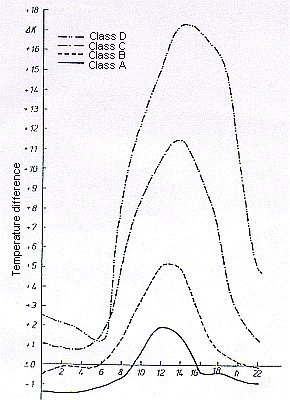The daily variation in the individual temperatures is of great significance to maintaining quality.
In addition to radiant conditions, external air temperatures, wind and precipitation also have an impact upon temperatures. The great daily variation in overall radiation results in a marked variation in temperature within the container. This variation primarily affects the temperatures of the container air and in particular of the bodies of air in those areas exposed to radiation (e.g. under the container ceiling).
Overheating of the air inside the container, i.e. heating to above the external air temperature, may be considerable even under normal conditions.
For example, daily overheating on sunny summer days amounts on average to 20°C even in temperate latitudes and is still higher in the subtropics. This means that temperatures of > 50°C, to which the surfaces of the cargo are exposed, may occur in the upper part of the container.
Four radiation classes were defined to describe radiation conditions, the classes being calculated on the basis of the measured duration of sunshine and solar altitude for 10 day measurement periods. The classes may be described in words as follows:
Class A:
Little or no effect of solar radiation. Average maximum overheating is 2.0°C (less than three hours of sunshine per day with low solar altitude, no radiant input on several days of the 10 day measurement period).
Class B:
Weak effect of solar radiation. Average maximum overheating is 5.2°C (four to eight hours of sunshine per day, but without sunshine on each individual day of the measurement decade).
Class C:
Moderate effect of solar radiation. Average maximum overheating is 11.5°C (up to twelve hours of sunshine per day, but without sunshine on each individual day of the measurement decade).
Class D:
Strong effect of solar radiation. Average maximum overheating is 17.3°C (more than twelve hours of sunshine per day, in general on all days).
Class A primarily occurs in Central Europe during the autumn and winter months, class B in the autumn and spring, class C in the summer and class D in periods of radiation weather in high summer which are similar to subtropical conditions.
Fig. 11 shows air overheating at an upper measurement point in a stationary container. The values were plotted by radiation class. It should be noted that the overheating values shown in Fig. 11 are averages. Overheating of 20 - 25°C was measured at an upper measurement point in the container in
0.0% of class A,
0.8% of class B,
5.4% of class C,
25.5% of class D,
as a proportion of all measurements, with overheating in class D being in the
15 - 25°C range in 83.6% of all cases. At an external air temperature of 25 - 30°C, air temperatures within the container may accordingly rise as high as 50 - 55°C.
 |
Figure 11: Average daily variation in overheating of the air inside a container, plotted by radiation class; Svenson [54] |